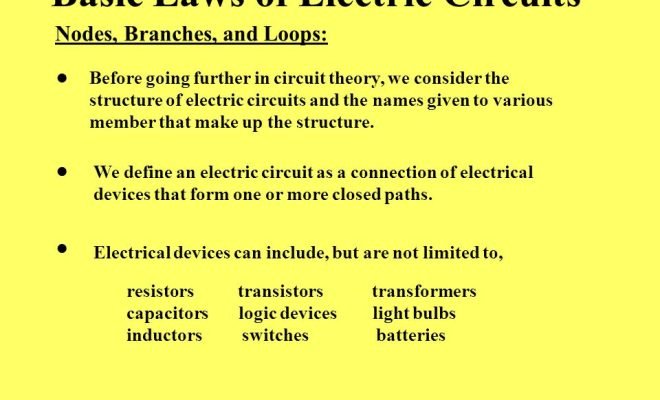Basic Circuit Laws

Basic circuit laws are fundamental principles that govern the behavior of electronic circuits. They are the foundation upon which all circuit analysis is based, and an understanding of these laws is essential for success in the field of electronics. In this article, we will cover the three primary circuit laws: Ohm’s law, Kirchhoff’s laws, and the power law.
Ohm’s Law:
Ohm’s law is perhaps the most fundamental principle in electronics. It states that the current flowing through a conductor between two points is directly proportional to the voltage across the two points, provided the temperature and other physical conditions remain constant. Mathematically, Ohm’s law can be expressed as:
V = IR
where V is voltage (measured in volts), I is current (measured in amperes), and R is resistance (measured in ohms). This relationship is used extensively in circuit analysis, especially in the design of power supplies and in the determination of resistive values for use in circuits.
Kirchhoff’s Laws:
There are two Kirchhoff’s laws: Kirchhoff’s Current Law (KCL) and Kirchhoff’s Voltage Law (KVL). KCL is based on the principle of conservation of charge and states that the sum of all currents entering and leaving a node in a circuit must be zero. Mathematically, this can be expressed as:
Σ I = 0
where Σ represents the sum of currents entering and leaving a node. This law is crucial in circuit analysis since it allows us to determine the current flow in a circuit and helps us to identify circuit faults.
KVL is based on the principle of conservation of energy and states that the sum of all voltage drops across a loop in a circuit must be equal to the sum of all voltage sources in the loop. Mathematically, this can be expressed as:
Σ V = Σ E
where Σ V represents the sum of all voltage drops in a loop and Σ E represents the sum of all voltage sources in the loop. KVL is crucial for circuit analysis since it helps us to understand how voltage is distributed in a circuit.
Power Law:
The power law is used to calculate the amount of power consumed by a device or circuit. It states that the power (P) consumed by a device is equal to the product of the current (I) and voltage (V) across the device. Mathematically, this can be expressed as:
P = IV
where P is power (measured in watts), I is current (measured in amperes), and V is voltage (measured in volts). The power law is essential in power supply design and in determining the power requirements of electronic circuits.
In conclusion, an understanding of basic circuit laws is fundamental to anyone working with electronics. Ohm’s law, Kirchhoff’s laws, and the power law are essential tools in circuit analysis and design. By following these fundamental principles, engineers and technicians can ensure the correct operation of electronic devices and systems.






